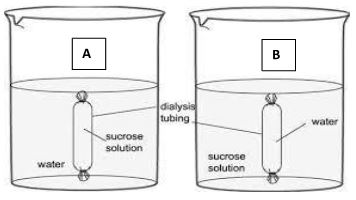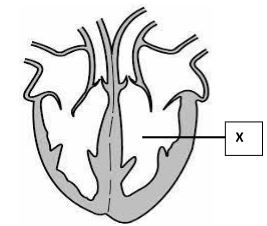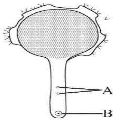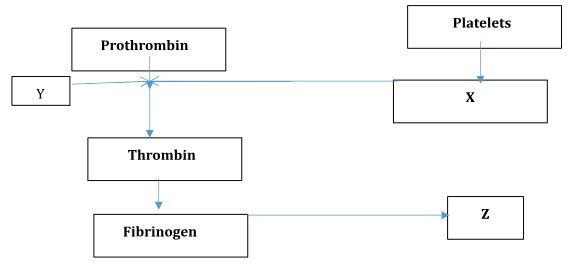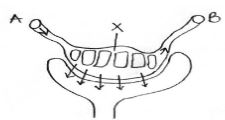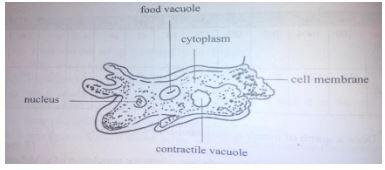Instruction To Candidates
- Answer all the questions in this question paper.
- Candidates should answer all the questions in english.
- A young scientist observed a bird laying her eggs in a nest and later the eggs hatched into chicks. Name two characteristics shown by the chicks that show a chick is a living thing but an egg is not. (2mks)
- In which two ways are the organelles chloroplast and mitochondria similar. (2mrks)
- The illustration below shows a human eye that is defective.
- Identify the eye defect. (1mrk)
- How would this defect be corrected? (1mrk)
-
- What is homeostasis? (1mrk)
- State three processes in humans in which homeostasis is involved. (3mrks)
-
- In which phase of photosynthesis are carbohydrates formed? (1mrk)
- How is the dark stage of photosynthesis dependent to light stage? (2mrks).
- Why are the cooling fans of value even in a closed room? (2mrks)
- How can the colour of the skin affect the rate of heat loss or heat gain? (3mrks)
- List down three abiotic factors that would influence life in a lake. (3mrks)
- Distinguish between the terms asexual and sexual reproduction (2mrks)
-
- Define the term germination. (1mrk)
- State the two types of germination in plants. (2mrks)
- When does growth start in plants. (1mrk)
-
- What is polyploidy. (1mrk)
- Mating a horse with a donkey produces an infertile animal, a mule. Explain. (2mrks)
- A part of DNA strand has the following base sequence: G-G-C-C-T-A-T-C.
- What is the sequence of the complimentary strand? (1mrk)
- What will be the sequence of m-RNA transcribed from this part of DNA? (1mtk)
- How does DNA differ from RNA? (3mrks)
DNA RNA
- A student made a set up shown below to study a physiological process
- In which beaker did the dialysis tubing reduce in size? (1mrk)
- Account for your answer in a) above. (2mrks)
- Give two reasons why lumbar vertebrae have long and broad transverse processes. (2mrks)
- Give two ways in which seed dormancy benefit a plant. (2mrks)
- State three precautions one should observe while conducting experiments in food test. (3mrks)
- Use the diagram of the heart shown below to answer the questions that follow
- From the diagram, give a reason to show that X is the left ventricle. (1mrk)
- Name a class of organisms where all members have the heart structure above (1mrk)
- Why are the muscles found in the heart above said to be myogenic? (1mrk)
- State the role of the following in the nitrogen cycle. (2mrks)
- Thiobacillus denitrificans.
- Nitrococcus bacteria.
- The diagram below shows the structure of germinating pollen grain
- Name the type of cell division that formed the parts labelled A. (1mrk)
- State the role of part labelled B? (1mrk)
- The chart below is a summary of blood clotting mechanism in a man.
Name;- The metal ion represented by Y. (1mk)
- The end product of the mechanism represented by Z. (1mk)
- The following is part of a kidney nephron
-
- Name the process represented by the arrows. (1mrk)
- Name the conditions necessary for the process named in (a) (i) above to take place. (1mrk)
- Identify with a reason vessel A. (1mrk)
-
- Name any two blood components that are present in vessel (A) but are absent in vessel B. (2mrks)
- State the function of the following during pregnancy. (3mrks)
- Amnion
- Amniotic fluid
- Umbilical cord
- Below is a diagram of an organism.
- Name the kingdom to which the organism belongs. (1mrk)
- Give a reason for your answer in (a) (i) above. (1mrk)
- Explain the process by which the food gets into the organism. (2mrks)
- State two characteristics features of members of division bryophyte. (2mrks)
-
-
- Name the cartilage between the bones of the vertebral column (1mrk)
- State the function of the cartilage named in (a)(i) above. (1 mark)
-
- Why do herbivores have large eyes on the side of their heads? (1mrk)
- Suggest three measures that can be taken to control infection of man by protozoan parasites. (3mks)
- In a family, all off springs have blood group AB. What are the possible blood groups of? the parents? (1mrk)
- List the changes that take place during inhalation in the breathing cycle of a mammal in the following: (3mrks)
- Rib cage thoracic cavity
- Diaphragm
- External intercostal muscles
- Evolution is an ongoing process, state two pieces of evidence which suggest that evolution is still taking place. (2mrks)
MARKING SCHEME
- (3mks)
- Growth and development
- Nutrition
- Movement and locomotion
- Excretion
- (2mrks)
- Both contain enzymes
- Both are oval in shape
- Both have double membrane
- (1mrk)
- Short sightedness (myopia)
- (1mrk)
- Concave (diverging) lens
- (1mrk)
-
- (1mrk)
- Maintenance of a constant internal environment in living organisms.
- (3mrks)
- Thermoregulation
- Osmoregulation
- Regulation of blood sugar level
- (1mrk)
-
- (1mrk)
- Dark stage
- (2mrks).
- Light stage generates hydrogen ions; and adenosine triphosphate used during carbon (IV) oxide fixation.
- (1mrk)
- (2mrks)
- Fans create air currents ; speeding up the loss of heat by radiation and evaporation.
- (3mrks)
- Dark surfaced bodies are the best heat absorbers;bright surfaces absorbs heat the least; good absorbers are also good emitters . In a hot surrounding dark skinned persons will gain heat faster than light skinned person;in cold environment,dark skinned persons lose heat faster.
- (3mrks). (any three answers)
- PH
- Light intensity
- Availability of mineral salts and trace elements
- Temperature.
- (2mrks)
- Sexual;is a type of reproduction that involves fusion of male and female gametes;
- Asexual reproduction is a type of reproduction in which offsprings are produced from mature organisms without fertilization.
-
- (1mrk)
- The process bywhich a plant developes into a seedling.
- (2mrks)
- Epigeal;Hypogeal
- (1mrk)
- When a mature seed germinates.
- (1mrk)
-
- (1mrk)
- Condition of the nucleus of a cell having more thanone set of chromosomes as per organisms belonging to that species
- (2mrks)
- The chromosomes are from different species; thus are not homologous to pair up during meiosis
- (1mrk)
-
- (1mrk)
- C-C-G-G-A-T-A-G
- (1mtk)
- C-C-G-G-A-U-A-G
- (3mrks)
DNA RNA Double stranded Single stranded Has deoxyribose sugar Has ribose sugar Confined in the nucleus Found in nuclease and cytoplasm Has nitrogenous base;adenine guanine cytosine and thymine Has nitrogenous base adenine ;guanine;cytosine and uracil
- (1mrk)
-
- (1mrk)
- B
- (2mrks)
- Sucrose solution is hypertonic; thus it gains water molecules by osmosis;
Accept: Water is hypotonic; thus water molecules move out of the dialysis tubing by osmosis; hence dialysis tube decrease in size
- Sucrose solution is hypertonic; thus it gains water molecules by osmosis;
- (1mrk)
- (2mrks)
- Increase surface area for attachment of abdominal muscles;
- Provide support /withstand weight of the abdomen.
- (3mrks)
- Allows time for dispersal
- Allows maturation of embryo
- Enables plant to survive harsh environment
- (3mrks)
- Avoid contaminating the reagents;avoid burning filter paper;avoid spilling reagents;avoid misuse of food substance
- Use the diagram of the heart shown below to answer the questions that follow
- (1mrk)
- Thicker muscular wall
- (1mrk)
- Mammalia; Aves;
- (1mrk)
- Contract without nervous stimulation/Initiate contraction on their own;
- (1mrk)
- (2mrks)
- Thiobacillus denitrificans. Converts nitrates to nitrogen gas and ammonia
- Nitrococcus bacteria. Oxidise ammonia to nitrites.
-
- (1mrk)
- mitosis
- (1mrk)
- Regulate Growth of pollen tube;
- (1mrk)
-
- (1mk)
- calcium ions
- (1mk)
- fibrin.
- (1mk)
-
-
- (1mrk)
- ultrafiltration process.
- (1mrk)
- High blood pressure
- Selectively permeable membranes
- (1mrk)
- (1mrk)
- Afferent arteriole:carries blood to the glomerulus for ultrafiltration process
-
- (2mrks)
- Nitrogenous waste;Glucose ;amino acids.
- (3mrks)
- Amnion ;forms amniotic cavity ;and encloses foetus and amniotic fluid.
- Amniotic fluid ; provides aquatic media for the foetus ; absorb shock;prevents dessication of the foetus
- Umblical cord ; connects placenta and the foetus ;supplying foetus with oxygen and the nutrients;Removes metabolic waste.
-
- (1mrk)
- Protoctista / Protista
- (1mrk)
- Single-celled eukaryotic organism.
- (2mrks)
- Membrane forms pseudopodia which is extended to surround and engulf the food particles and then form a food vacuole.
- (1mrk)
- (2mrks)
- Presence of rhizoids
- Absence of vascular tissues
- Body parts not differentiated into roots, stem and leaves
-
- (1mrk)
- Intervertebral disk.
- (1 mark)
- Absorb shock ;reduce friction during movement; allows for certain degree of flexibility of vertebral column.
- (1mrk)
- (1mrk)
- To give them a wider field of view that enables them to track their enemies from far and therefore take precautions.
- (3mks)
- Proper disposal of human waste/faeces;
- Destroy breeding sites of vectors
- Proper cooking of food /boiling of drinking water;
- Use of insecticide against vectors / drugs against pathogens
- Use of protective dwelling /mosquito nets to prevent vector bites/ proper hygiene;
- (1mrk)
- AA and BB ;(must indicate the two genotypes to get one mark.)
- Ribcage; thoracic cavity: Moves upwards and outwards Diaphragm- Flattens (due to contraction of muscles); External intercostals muscles-contract; (3mrks)
- (2mrks)
- Natural selection in action;industrial melanism; Resistance to drugs;pesticides; and acaricides;
Download Biology Paper 1 Questions and Answers - Lanjet Joint Mock Exams 2023.
Tap Here to Download for 50/-
Get on WhatsApp for 50/-
Why download?
- ✔ To read offline at any time.
- ✔ To Print at your convenience
- ✔ Share Easily with Friends / Students


